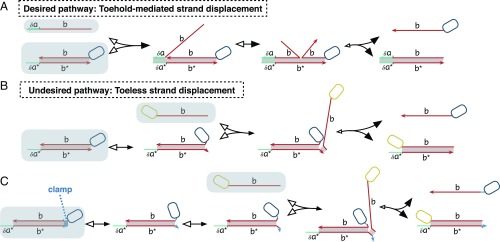Fig. 1.
Desired and leak strand displacement reactions. Letter labels represent domains, which are contiguous bases that logically act as a unit. The domains with complementary sequences are labeled with asterisks. The black arrowheads show the direction of forward reactions, and the white arrowheads show the direction of backward reactions relative to the illustrated reaction pathway. Small arrowheads indicate reactions that are expected to be slow relative to other steps. Shaded background indicates molecular species that are initially present. Toehold domains are labeled by the symbol and a thicker strand line. (A) Intended strand displacement reactions are initiated by binding of a toehold (domain ) followed by the displacement of the incumbent strand by the matching portion of the invader strand (domain ). The participating strands can have other domains on either side of the involved displacing region; for example, the dark blue rounded rectangle box represents the part of the released strand on the 5′ end not involved in this interaction. (B) Leak is hypothesized to be caused by toeless strand displacement reactions, which start from the fraying of the end of a DNA helix where no neighboring base pairs can help stabilize the structure. (Here, both ends of the helix could fray. The figure only shows one scenario.) After they are frayed, the opened nucleotides can be the initiation point for the undesired strand displacement. The invading strand can be a part of a larger complex, which is indicated by the yellow rounded rectangle box. (C) Short clamp domains (indicated by a darker shaded helix) help to reduce leak. The toeless displacement on the right side of the helix now requires larger fraying as shown. (Note that the clamp shown does not inhibit toeless displacement on the left side of the helix.)

